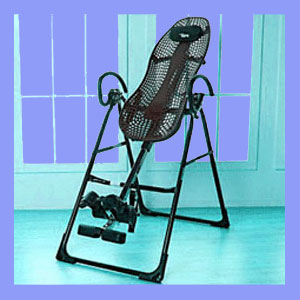
Inversion for sciatica is a historical treatment for many types of back pain and is still very popular today. Inversion therapy consists of hanging upside down, thereby counteracting the forces of gravity on the spine. Basically, this treatment is a crude method of spinal decompression, which might help some patients experience relief from certain painful sciatic nerve conditions.
Inversion is popular, since it can be used at home with a one time investment in equipment. Furthermore, many patients cite health benefits ranging far beyond simple pain relief.
This article will help clarify how and why inversion is utilized to treat sciatic nerve symptoms.
What is Inversion for Sciatica?
Inversion therapy has been used for thousands of years to treat a wide range of problematic health issues. Inversion has even been used as a torture and method of execution. Inversion found a real home in the fitness industry as many trainers discovered its potential for increasing the strength and conditioning of the core muscles, including the abdominals and postural back muscles.
Inversion as a medical therapy is still practiced for several conditions and is especially known for treating back pain. However, it is still best known as a home remedy, using inversion tables or boot and rack systems.
Types of Inversion Therapy
Inversion boots are the cheapest and easiest way to begin an inversion program at home or at the gym. These specialized ankle restraints lock into a rack system which is then inverted, literally hanging the person completely vertical and upside down. This form of inversion is usually used for fitness applications, since it is vigorous, difficult to achieve and can be extremely painful for anyone with a pre-existing back pain syndrome.
The most common medical type of inversion involves an inversion table, which is easier and safer to operate. Once a patient is locked into the table, the unit can be easily inverted by manual controls and the table will be adjustable to provide variable degrees of inversion.
Some patients find the best results from a slight angle of head down inversion, while others insist on full vertical positioning.
Inversion tables support the back while inverted, providing much more security and comfort than boot systems could ever hope to achieve.
Some patients have been known to use home made or adapted inversion devices, such as a weight bench placed for a decline bench press position or simply a large foam wedge placed under the back with the head facing downwards.
Efficacy of Inversion for Sciatica
I have tried inversion for both back pain relief and fitness applications. I found it to be far more bother than it was worth for fitness and completely ineffective for my chronic sciatica pain. Nevertheless, many patients swear by the results they have achieved with inversion and would never give up using their inversion tables.
I often see these devices sold on late night TV infomercials with all these happy looking perfect people smiling away while inverting themselves. These are typically lightweight, cheaply-made versions of professional tables offered at a bargain basement price. Somehow, these commercials always make me laugh.
I have spoken to at least a half dozen chiropractors who continue to recommend inversion to their patients and conveniently, happen to sell the high priced tables directly in their offices. I wonder if this is a coincidence or not. I think the high mark up on the products might explain quite a lot, but I would still love to hear the sales pitch to a patient who can’t even lie down comfortably, let alone invert.
Sciatica > Spinal Decompression for Sciatica > Inversion for Sciatica





